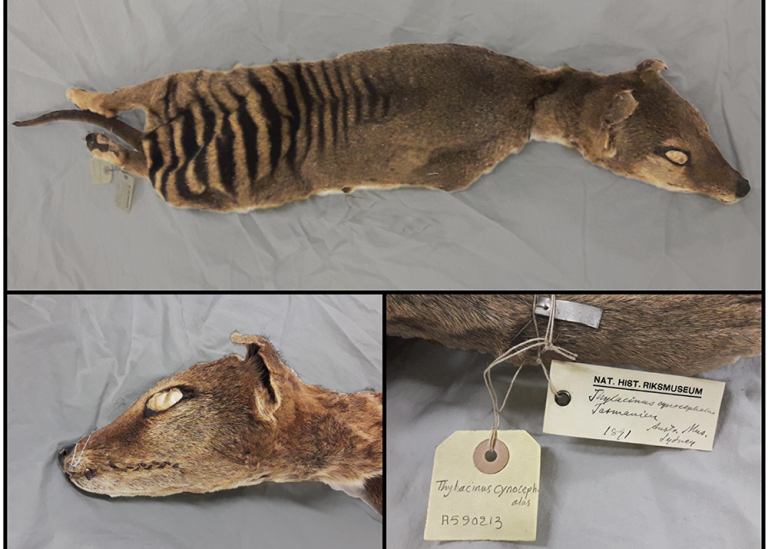Reviewed by Danielle Ellis, B.Sc.Sep 20 2023
New research demonstrates the isolation and sequencing of RNA molecules from a Tasmanian tiger specimen kept at room temperature in a museum collection over a century ago. For the first time, skin and skeletal muscle transcriptomes from an extinct species were reconstructed.
 Tasmanian tiger specimen used in the study and preserved in desiccation at room temperature in the Swedish National History Museum in Stockholm. Image Credit: Emilio Mármol Sánchez (photograph) and Panagiotis Kalogeropoulos (editing)
Tasmanian tiger specimen used in the study and preserved in desiccation at room temperature in the Swedish National History Museum in Stockholm. Image Credit: Emilio Mármol Sánchez (photograph) and Panagiotis Kalogeropoulos (editing)
The researchers emphasize that their findings have ramifications for worldwide attempts to restore extinct species such as the Tasmanian tiger and the woolly mammoth, as well as studies into pandemic RNA viruses.
The Tasmanian tiger, commonly known as the thylacine, was a magnificent apex carnivorous marsupial that formerly roamed the Australian continent and Tasmania. This unique species met its end following European colonization when it was deemed an agricultural nuisance and a bounty of £1 was instituted by 1888 for each full-grown animal slain. The last known surviving Tasmanian tiger died in captivity in 1936 at Hobart’s Beaumaris Zoo.
Efforts in De-Extinction Focused on the Tasmanian Tiger
Recent de-extinction attempts have concentrated on the Tasmanian tiger, whose native habitat in Tasmania is still mainly maintained, and whose restoration might assist in restoring historical environmental equilibriums lost following its extinction.
However, rebuilding a functioning live Tasmanian tiger needs not only a thorough understanding of its genome (DNA) but also of tissue-specific gene expression dynamics and gene control, which can only be obtained by researching its transcriptome (RNA).
Resurrecting the Tasmanian tiger or the woolly mammoth is not a trivial task, and will require a deep knowledge of both the genome and transcriptome regulation of such renowned species, something that only now is starting to be revealed.”
Emilio Mármol, Study Lead Author, Stockholm University
The study was published in Genome Research by SciLifeLab researchers in partnership with the Centre for Palaeogenetics, a collaboration between the Swedish Museum of Natural History and Stockholm University.
RNA Molecules Recovered from the Tasmanian Tiger
The researchers behind this study analyzed the transcriptome of skin and skeletal muscle tissues from a 130-year-old desiccated Tasmanian tiger specimen maintained at room temperature at Stockholm’s Swedish Museum of Natural History for the first time. This resulted in the discovery of tissue-specific gene expression profiles that are similar to those seen in current marsupial and placental animals.

Image Credit: CROCOTHERY/Shutterstock.com
The recovered transcriptomes were of such high quality that muscle- and skin-specific protein-coding RNAs could be identified, as well as missing ribosomal RNA and microRNA genes annotated in accordance with MirGeneDB standards.
This is the first time that we have had a glimpse into the existence of thylacine-specific regulatory genes, such as microRNAs, that got extinct more than one century ago.”
Marc R. Friedländer, Associate Professor, Department of Molecular Biosciences, The Wenner-Gren Institute, Stockholm University
Vast Collections of Specimens and Tissues at Museums
This groundbreaking finding offers up new and intriguing possibilities and implications for researching the massive collections of specimens and tissues held at museums throughout the world, where RNA molecules could be waiting to be discovered and analyzed.
In the future, we may be able to recover RNA not only from extinct animals, but also RNA virus genomes such as SARS-CoV2 and their evolutionary precursors from the skins of bats and other host organisms held in museum collections.”
Love Dalén, Professor, Evolutionary Genomics, Stockholm University
The study’s authors are thrilled about future holistic research advancements that will integrate both genomes and transcriptomics, ushering in a new age in paleogenetic beyond DNA.
Source:
Journal reference:
Marmol-Sanchez, E., et al. (2023). Historical RNA expression profiles from the extinct Tasmanian tiger. Genome Research. doi.org/10.1101/gr.277663.123